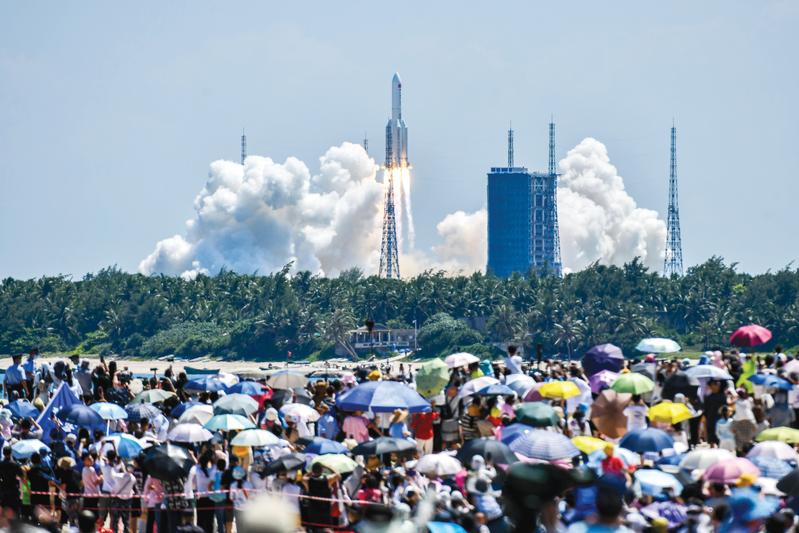As nation makes giant strides with rocket launches, interplanetary expeditions and the Tiangong program, a coastal township in Hainan rides to prosperity
 Residents gather to witness the launch of a Long March 5B rocket in Wenchang, Hainan province, on July 24. (LUO YUNFEI / CHINA NEWS SERVICE)
Residents gather to witness the launch of a Long March 5B rocket in Wenchang, Hainan province, on July 24. (LUO YUNFEI / CHINA NEWS SERVICE)
Editor’s note: In this series, China Daily looks at some of the areas in which major progress has been made in the 10 years since the 18th National Congress of the Communist Party of China was held in November 2012.
Chen Li, a 62-year-old restaurant owner in Longlou, a coastal township in China’s southernmost island province of Hainan, said he is grateful to the country’s space industry, which has increased the business at his eatery over the past several years.
“There were so many people coming to Longlou before the launch of the Wentian space lab. There was ‘a mountain of people, a sea of people’. A lot of tourists came to my restaurant to have a taste of Wenchang chicken,” he said, referring to a renowned local delicacy.
Chen said that although he opened his first restaurant in 1992, it was not until 2016 that his business began to flourish — thanks to the space launch missions that began to be carried out that year at the Wenchang Space Launch Center in Longlou, the youngest space base in China and the only coastal one.
“Since the first launch at the center (in June 2016), the number of tourists keeps rising every year, and my business continues to blossom. Many tourists told me that they came here to watch the splendid scenes of launching a rocket and would also spend some days in the town visiting local scenery,” the businessman said.
He added that before the Wentian mission, which was launched in July this year, he had never seen so many travelers in Longlou.
“I think at least 100,000 people flooded into Longlou before the launch. Rooms at all of the inns, hostels and hotels that I know of had been booked up many days before the scheduled date for the spaceflight. I also hired part-time waiters and prepared more food for the swarm of tourists.”
According to the township government, more than half a million tourists were in Longlou on July 24 to see the launch of Wentian.
Chen said he owes a debt of gratitude to the nation’s space endeavors.
“Because of the space programs, my business is now 10 times more than it was in the years before the launch missions came here. Without them, our lives could never have been as good as they are now,” he said, adding that he sets off fireworks in front of his restaurant each time a carrier rocket is successfully launched from the Wenchang center.
In addition, Chen said, many local people who had worked elsewhere have returned to Longlou to start their own businesses, hoping to reap the benefits from opportunities brought about by the space sector.
Local authorities said there are now nearly 1,000 shops and hospitality-related businesses in Longlou — four times the number it had before 2016. Residents’ average annual income had reached 19,171 yuan ($2,720) by the end of 2021, which is 40 percent higher than in 2016.
Besides their increased wealth, Chen and his fellow Longlou residents have been witness to a host of ambitious space programs, including the country’s permanent space station project, that have made China a rising space power.
Both of the two major components comprising the current Tiangong space station, now traveling in an orbit 400 kilometers above Earth, were carried into space by a Long March 5B heavy-lift rocket launched from the Wenchang center.
The first and most important part of the Tiangong station — the Tianhe core module — was launched in April 2021, marking the beginning of a historic project that had been advocated by Chinese scientists since the 1980s.
Tianhe is 16.6 meters long and has a diameter of 4.2 meters. The craft’s weight, at 22.5 metric tons, is equal to the combined weight of 15 standard-size automobiles.
 An aerial view of Longlou township in Wenchang, Hainan province. (GUO CHENG / XINHUA)
An aerial view of Longlou township in Wenchang, Hainan province. (GUO CHENG / XINHUA)
The module is bigger and heavier than any other Chinese spacecraft launched before it.
Inside the craft are about 50 cubic meters for astronauts to live and work in — much bigger than the available area of previous Chinese manned spacecraft. There are separate quarters for working, sleeping, personal hygiene, dining, healthcare and exercise. The module also has appliances such as an air conditioner and a microwave oven, refrigerator, water dispenser and treadmill.
In late July, Tiangong’s first lab module, named Wentian, was launched to connect with the Tianhe.
With a weight of 23 tons and length of 17.9 meters, Wentian is currently the largest and heaviest spacecraft that China has ever built, and is also the world’s heaviest self-propelled spaceship in service.
Inside the gigantic lab are eight scientific cabinets. They are mainly used to serve biological and life science studies and can support research on the growth, aging and genetic traits of plants, animals and microbes in the space environment.
Wentian also carries 22 extravehicular payload adapters capable of carrying scientific equipment needed for experiments that require exposure to the space environment, cosmic rays, vacuum and solar winds.
So far, three groups of Chinese astronauts have lived and worked inside the Tiangong space station, which now consists of the Tianhe module, the Wentian lab, the Shenzhou XIV spacecraft and the Tianzhou 4 cargo ship.
The current crew — the three members of the Shenzhou XIV mission — have spent nearly four months in the station and have carried out two spacewalks. They are scheduled to continue flying with the station until early December, when the Shenzhou XV crew will take over.
The Mengtian space lab, Tiangong’s second lab component, is scheduled to be launched from Wenchang in October.
Scientific equipment onboard that component will be used for microgravity studies and to carry out experiments in fluid physics, materials science, combustion science and fundamental physics, according to mission planners.
Once Mengtian is connected to Tiangong, the station will be T-shaped, and astronauts will have as much as 110 cubic meters of usable space.
Serving as a national space-based platform for science and technology, Tiangong is expected to operate in orbit for around 15 years and will be open to foreign astronauts in the near future, according to the China Manned Space Agency.
Not far from the Wenchang launch center, construction of a new space complex began in July, and aims to become China’s first launch site dedicated to commercial missions.
The Hainan Commercial Space Launch Site is a joint venture of the Hainan government and three State-owned space conglomerates. It is expected to tap the increasing demand from private space enterprises for launch infrastructure.
“The existing government-run launch centers are well developed, but they are too busy to handle the increasing demands from the commercial space sector, and it is not uncommon that even a government-assigned mission would have to wait for arrangement at those sites,” said Hu Shengyun, a senior rocket designer at China Aerospace Science and Industry Corp.
As of now, two private companies in China, i-Space and Galactic Energy —both of these headquartered in Beijing — have succeeded in orbital missions, which refer to carrier rocket flights that transport spacecraft into an orbit in outer space.
The leader in the private rocket sphere, Galactic Energy, has performed three successful launches using its Ceres 1 solid-propellant rocket.
Xia Dongkun, a vice-president of Galactic Energy, said in August after the third Ceres 1 flight that three consecutive successes are enough to put an end to the rocket’s trial phase, and that the model is ready for commercial operations.
Engineers have begun making components for nine new Ceres 1 rockets. The company expects to conduct two or three launches before the end of the year, he said.
According to Xia, engineers at his company are developing the Pallas 1, a larger, liquid-propellant rocket model that can be reused.


